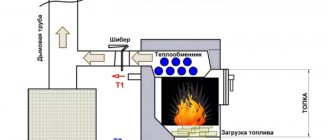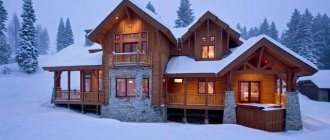Advantages and disadvantages
There are many advantages of heating with wood. The main thing is their low cost. It is lower than the price of gas or electricity. Moreover, even wood waste can be used for this type of heating. Moreover, not all settlements in our country are gasified. This is especially true for villages in rural areas. Heating with logs is also great for summer cottages.
An important factor when choosing heating with wood is the environmental friendliness of this fuel and the comfort it allows you to feel. This is not only warmth, but also visual pleasure from the sight of burning wood in a fireplace or in a stove equipped with a panoramic transparent screen, which is usually built into the fuel loading door.
Heating with wood also has disadvantages. First of all, this is the lack of automation. After all, you will have to load the fuel into the stove, boiler or fireplace yourself, and this takes a lot of time and effort. In this regard, heating with logs is significantly inferior to gas and electric heating systems. After all, they can be operated with virtually no human intervention.
You will need to take care of a supply of firewood in advance. You can buy them or prepare them yourself. In addition, if the house area is large, you will have to additionally use radiators, since it is unlikely that it will be possible to achieve good heating using only a fireplace or stove. Especially in winter. It is best to use a boiler with a water circuit.
Despite the fact that firewood is affordable for everyone, you will need to spend money on installing a stove, boiler or fireplace. And this “pleasure” cannot be called cheap. You will also have to install all the additional equipment that you will need to efficiently heat your home.
Maintenance and care of a wood boiler
The main problem when operating equipment is the timely removal of combustion products. Ash is removed regularly. The high organic content in natural wood leads to rapid contamination of pipelines. The chimney becomes clogged several times faster than when using a gas boiler. With certain skills and available tools, this operation can be carried out independently. If this is not possible, then specialists are called. If the chimney is operated with a gas boiler running, then a successful pipeline configuration allows the operation to be carried out every few years. Wood-burning units require more frequent intervention. Depending on the design, the chimney is cleaned 1-2 times a year. If, with such a schedule, a significant decrease in the efficiency of the system is noticed, you should contact professionals to modify the route and improve the performance characteristics of the removal of combustion products.
Over the course of a year, 10-15 m3 of wood is used to heat a house. Prepare it in advance. Care should be taken to ensure that fuel is stored in a place protected from precipitation. A canopy will be enough. Good ventilation during installation also contributes to effective drying. The type of wood is of great importance. Conifers such as pine, spruce, and cedar are not among the best types of fuel, but they are inexpensive. Deciduous species provide greater heat output - birch, beech, oak, ash. These rocks are considered valuable, and only waste and non-business materials are used as fuel.
Boiler in need of cleaning Source vsaunu777.ru
Proper production of wood heating
Modern heating systems using wood fuel have significant differences from the schemes used previously.
Attention: Brick stoves, which acted as a heat exchanger, transferring the generated heat into the room, have been replaced by modern fireplaces, boilers and stoves.
The choice of heating device depends on the availability of free space for installation and the area of the building. When choosing a wood heating system, you need to pay attention to the following factors:
- Thermal power of the device. It depends on the area of the house, the degree of its thermal insulation and the climate zone in which it is located.
- The need to allocate space for a boiler or furnace. A device for heating with wood fuel must be installed in a room specially designated for this purpose, which must meet certain requirements. In particular, have stable ventilation.
- Availability of space for fuel storage. Wood must not be stored in a room containing a stove or boiler. They must be stored separately.
To decide on the device that is best suited for heating with wood, you should take into account the parameters of the building and your financial capabilities . As practice shows, the most popular and effective option is to use a double-circuit boiler with a water circuit in a private house. It will allow you not only to efficiently warm the building, but also to always have hot water at hand. But in order to make the final choice in favor of one or another device for heating with wood, you should consider each of them in more detail.
Be sure to read: types of heating systems in a wooden house.
Heating schemes for a private house with a wood-burning boiler
At the moment, there are several ways to install a wooden boiler. First of all, you need to pay attention to the structure and details of the boiler, as well as the features of the room - then you can choose the layout. All schemes can be divided into the following large categories:
- Forced circulation - in this case, the system structure uses a circulation pump, which is the main source of pressure. But here the system is completely dependent on electricity.
- Natural circulation - works due to the expansion of the liquid during the heating process. In this case, the coolant moves independently throughout the structure. However, during installation it is necessary to strictly follow the instructions, which stipulate the dimensions of the slopes and angles. In this case, it is better to turn to professionals.
- Single-pipe system - each battery is connected one after the other. Each radiator receives a water circuit, and then the liquid goes back to the boiler. But what
- The farther the boiler is located, the less heat transfer will be.
- Two-pipe system - the return and supply water supply are connected to one radiator at the same time. As a result, heat is supplied evenly.
When installing a liquid system, it is necessary to draw up a detailed plan, and also comply with all requirements and standards during the work. If we are talking about a two-story house, then you need to approach the wiring with all responsibility and be sure to install a security group.
Heating schemes for a private house with a wood-burning boiler
Wood heating options
To keep the house warm, you should choose the right wood heating for a country or private house that will be used. As already mentioned, a stove, fireplace or boiler can be used for this purpose.
Attention: When choosing, you should take into account the number of rooms and the area of the building.
Usually, if the house is small, a stove or fireplace is installed. Otherwise, it is better to install a boiler with a water circuit. Let's take a closer look at each option:
- Stove heating is characterized by high efficiency and a small heating area. But at the same time, it is the easiest to install. Furnace heating is suitable for buildings with an area of no more than 60 m².
- Water heating includes a boiler (fireplace, stove) with a pipeline connected to it. Thermal energy is transferred through radiators. This heating option is good for buildings larger than 80 m².
- Fireplace heating is in many ways similar to stove heating. The main difference is a more spacious combustion chamber. In some cases, such a boiler may have a hob.
The heating system using wooden logs can be significantly improved. For example, you can install a heat exchanger in the furnace, which will create a full-fledged water heat supply.
But most often a wood boiler is used to heat a house. It is much simpler and more practical to use than a stove or boiler. In addition, it can be made independently.
Choosing the best firewood for heating
If we compare wood and hydrocarbon fuels, the latter has significantly greater heat transfer. Therefore, to heat a room with wood, you need almost twice as much biomass as compared to a gas energy source.
This explains the frequent and regular replenishment of the firebox with wood. This is especially noticeable when the equipment is used at maximum power.
In this case, there are several ways that can increase the time interval between loadings of wood:
- select the appropriate heating unit, which is equipped with a volumetric combustion chamber;
- using firewood with maximum heat output, which generates a lot of heat.
Advice: The brick version of the stove does not have a large combustion chamber, compared to modern models of wood-burning boilers and during the heating stage they require frequent loadings of raw materials. But already during active operation, the stove’s need for wood decreases, and the generated heat is retained for a long time.
Brick wood stove
Different types of wood have different heat transfer, which largely depends on the combustion temperature of the fuel. More heat is released from heat-producing wood.
The most effective thermal characteristics are those of oak, ash and others. The worst firewood comes from poplar, as it gives off virtually no heat. In order to know which firewood should be preferred, check out the data in the table.
| Breed | Heat productivity, % (100% - maximum) | Temperature, C |
| Beech, ash | 87 | 1044 |
| Hornbeam | 85 | 1020 |
| Winter oak | 75 | 900 |
| Larch | 72 | 865 |
| Summer oak | 70 | 840 |
| Birch | 68 | 816 |
| Fir | 63 | 756 |
| Acacia | 59 | 708 |
| Linden | 55 | 660 |
| Pine | 52 | 624 |
| Aspen | 51 | 612 |
| Alder | 46 | 552 |
| Poplar | 39 | 468 |
In practice, home owners rarely select the required type of wood, since high-quality raw materials are a real luxury. Often, they choose the most available wood in their area.
In addition to the type of wood, special attention must be paid to the condition of the firewood. Even the best varieties will not give the expected effect if they remain wet. This figure should reach up to 25% in the finished fuel version. If the humidity of the firewood is higher, then you will not receive the maximum amount of thermal energy and will consume more fuel.
Making a wood-burning boiler yourself
Making a wood-burning boiler with your own hands is not at all difficult. You just need to choose the right grade of steel. Its thickness must be at least 1.5 mm. It is recommended to manufacture the boiler by welding. But since this takes a lot of time, steel barrels with the required wall thickness are often used.
It is best if the barrel capacity is 200 liters. It must be cut lengthwise and a partition made inside. This will be required to install the wheels. A hole is made at the end for mounting the door, which is recommended to be selected in advance. You will also need a chimney with a diameter of no more than 10 cm. It is located on the reverse side and serves to remove carbon monoxide.
But if you intend to install a heating boiler made by yourself, you should know that it has some disadvantages. First of all, this is low efficiency and short service life. In addition, if you accidentally touch its surface, you can get burned, as it gets very hot.
A DIY wood-burning boiler is perfect for heating various outbuildings with a small area. For example, a barn, garage, etc.
If you need to heat a country or private house, it is best to install a factory model, which will be of much better quality and will allow the building to be heated well.
Economic benefits when using a wood boiler
It is no coincidence that many reputable manufacturers have launched the production of equipment in this category. The demand for it is high not only in Russia and the CIS countries. Today, wood-burning boilers for homes with water heating are successfully used in many regions of Europe, America and Asia. The secret is simple - high prices for gas and electricity have led to the fact that servicing the corresponding equipment is expensive. In many countries, the production of pellets from waste from the woodworking and furniture industries has been established. The granules take up little space and are highly energy efficient. Moderate prices make their use extremely attractive. The cost of heating a house of 100-150 m2 with wood at the average market price is 10,000 -15,000 rubles. This is even lower than when using gas, although it is considered the most cost-effective energy carrier. In practice, it turns out that using the latest generation high-performance wood-burning boiler is more profitable than connecting gas equipment. Electricity will cost even more.
Design project for an individual boiler room Source stroi-archive.ru
In regions where cheap wood is available, these figures are even more impressive. In some areas there is a quota for independent fuel procurement. There are many wood processing enterprises across the country, for which a constant problem is the presence of large amounts of waste. Not all enterprises in the industry have established full processing lines. If there is such a production in the neighborhood, then installing a wood-burning boiler will significantly save the family budget.
Boiler room arrangement
Wood heating of a country house involves the allocation of a room in which the boiler and devices for its control will be located. This room must meet the following parameters:
- the presence of a smoke channel with a height of at least 4 m;
- area of at least 6 m²;
- the presence of combined lighting;
- ceiling height is not less than 2.5 m;
- presence of forced ventilation.
Attention: The decoration of the room must be made from fire-resistant materials. If the boiler has electrical elements, there must be an electrical supply line.
Heating using a solid fuel boiler
The second method of heating a country house with wood is to use a full-fledged heating system with a solid fuel boiler as heating equipment. At the same time, there are different boilers for each type of solid fuel; it is necessary to purchase a wood-burning boiler, and not a pellet or peat boiler.
It is necessary to place dry firewood into the combustion chamber of the boiler from time to time. When they are burned, heat is released, which heats up the coolant. Combustion is regulated by opening and closing the damper. The more air enters the combustion chamber, the more intense the combustion process.
Heating the cottage with wood
In a country rich in forests, wood heating is the most popular and inexpensive. The main disadvantage in this case is the need to constantly maintain the temperature in the boiler for comfortable living in the house. When planning to heat your dacha, it is worth considering installing a combination boiler that operates on several energy sources. You can install a boiler that runs on solid fuel with a possible transition to liquid or electricity.
If you visit your dacha exclusively in the summer, you can install a fireplace in it. This will not only allow you to heat the room at night or during a sharp cold snap, but will also add an additional romantic touch to the design of the dacha. It’s wonderful to sit by an open fire, listen to the crackling of logs, and watch the flames dance. Such a pastime is a great way to relieve the stress of a busy day. Heating a dacha with wood is more of an aesthetic nature than a practical one, if you do not plan to live in it for a long time, but are coming only for a short time to relax.











